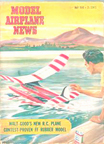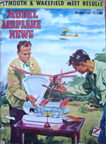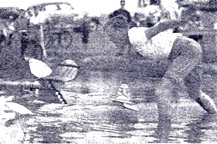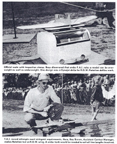May, 1949


Model Airplane News Covers for May and November 1949
Celebration of "Rise Off Water" Events
Drawing by Jo Kotula
Click to Enlarge
In model airplane competition, one of the oldest and least covered events is the "Rise Off Water" or R.O.W. specialty. As the name implies, the event is for seaplanes, or models equipped with floats. The casual observer might say "what's the difference - land or water takeoff?" The R.O.W. event is, in fact much more difficult due to the basic nature of hulls and water.
Theory: The maximum speed is an inverse function of the wetted area. Large wetted area implies slow speed and conversely low wetted area implies high speed. You cannot put a rocket on a barge and get it moving at 100 mph -- in fact, speed above the limit prescribed by the wetted area will simply drive the vessel into the water. Similar things happen to sailing ships in hurricanes and sailors go to extreme lengths to slow the ship down even to the extent of removing the masts.
The "floats" on a seaplane are actually hulls subject to the same laws of physics as the largest battleship. If the takeoff speed of the airplane part exceeds the "hull speed" of the floats then the airplane will just sink. Thus, for takeoff, the floats must have minumum wetted area or at least a wetted area that will allow the plane to reach lift off speed.
There is another complication that would prevent floats from being designed like razor blades -- buoyancy increases with wetted area (a barge holds more than a sailboat...) Knifelike floats will not support the airplane and once again, it will sink.



Theory of Float Design
Glenn Curtiss Stepped Hull Patent No. 1,256,878
Click to Enlarge
The acceped solution for floatplanes is a two-phase hull that has a broad beam at rest, but tapers to a knife-like edge. This is known as a "stepped hull." Glenn Curtiss, the famous designer of flying boats was the first to do research in this area in conjunction with airplanes. His key patent is listed above and we have also reproduced an article on "Scientific Float Design" that was printed in the April, 1950 issue of Model Airplane News.
Free flight seaplanes are subject to the same engine displacement rules as "Rise Off Ground" planes. Here are some selections from the rules that specifically govern ROW competition:
- 5. Seaplane Models (ROW). Models shall have hull, floats, or pontoons that permit takeoff and which shall be capable of maintaining the model afloat unassisted for at least 30 seconds in the takeoff position with only the hull, floats, or pontoons immersed in the water. A rise-off-water model must be released without any push whatsoever. Models need not alight on water at the end of flight. Vertical takeoff not permitted.
- 7. Total Weight. Free Flight models shall be limited to a total flying weight of not more than seven (7) pounds, four (4) ounces.
This, the competition hinges on an unassisted takeoff and weight (given engine size). These two factors are celebrated in Jo Kotula's covers for May (unassisted takeoff) and November (weight)


Launch and Weighing
Click to Enlarge
Here is a video that shows model aircraft from 1930-1960; you'll find several examples of ROW aircraft in there.
As you'll note, some competitions stage ROW over an actual body of water while others use a water-filled tank. Click here to read the actual rules governing the event.

Click to go back and select another cover.
Counter for the Entire Site (not just this page..)
Home | About Lindy | Last Week's Reviews | Upcoming Events | 1940s Collecibles
The Guide - Establishments - Travel - Accessories
Music | Links | Photo Gallery | Extras | Contact